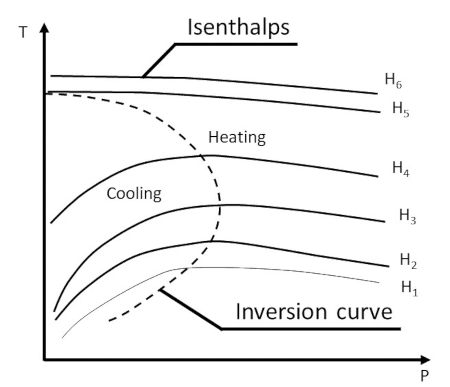20.19 : Joule-Thomson Effect
The Joule-Thomson effect, also known as the Joule-Kelvin effect, describes the temperature change of a fluid when it is forced through a valve or porous plug while keeping it in a thermally insulated environment. This experiment is called a throttling process. This is an important effect widely used in refrigeration and the liquefaction of gases.
This experiment forces high-pressure gas through a throttle valve or a porous plug to a lower-pressure region. The gas expands as it passes through to the low-pressure region and occupies the volume, which is larger than the initial volume. Work is done on the gas when gas is forced through a throttle valve. However, when it expands, work is done by the gas on the surroundings. The temperature of the gas varies in this process; hence, it attains a new internal energy. The change in internal energy of the gas must be equal to the work done on the gas minus the work done by the gas. It is found that enthalpy is conserved (isenthalpic) in this flow process.
The change in temperature of the gas when pressure is reduced at constant enthalpy is given by the Joule-Thomson coefficient:

Since the temperature of the gas varies, the Joule-Thomson coefficient can take either sign, depending on whether the gas becomes heated or cooled. The inversion curve in the T-p plane explains the heating and cooling of gas during the throttling process.

The inversion curve separates the region of heating from the region of cooling. The maxima of the different isenthalps lie on the inversion curve. Note that an isenthalp is the locus of the end points of different throttling processes, starting at the same initial state. Depending on where the initial and final points are chosen, both heating and cooling effects can be produced during the throttling process.
The Joule-Thomson coefficient is zero for an ideal gas, indicating there is no temperature change when an ideal gas undergoes a throttling process. The coefficient is negative for real gases at extremely high and extremely low temperatures.
章から 20:

Now Playing
20.19 : Joule-Thomson Effect
熱力学の第一法則
2.6K 閲覧数

20.1 : 熱力学系
熱力学の第一法則
4.8K 閲覧数

20.2 : ボリューム変更中に行われる作業
熱力学の第一法則
3.7K 閲覧数

20.3 : 熱力学状態間のパス
熱力学の第一法則
2.9K 閲覧数

20.4 : 熱と自由膨張
熱力学の第一法則
1.6K 閲覧数

20.5 : 内部エネルギー
熱力学の第一法則
4.3K 閲覧数

20.6 : 熱力学の第一法則
熱力学の第一法則
4.0K 閲覧数

20.7 : 熱力学の第一法則:問題解決
熱力学の第一法則
2.4K 閲覧数

20.8 : サイクリックプロセスと孤立したシステム
熱力学の第一法則
2.7K 閲覧数

20.9 : 等温プロセス
熱力学の第一法則
3.5K 閲覧数

20.10 : アイソコリックプロセスとアイソバリックプロセス
熱力学の第一法則
3.2K 閲覧数

20.11 : 理想気体の熱容量I
熱力学の第一法則
2.5K 閲覧数

20.12 : 理想気体の熱容量II
熱力学の第一法則
2.3K 閲覧数

20.13 : 理想気体の熱容量III
熱力学の第一法則
2.1K 閲覧数

20.14 : 理想気体の断熱過程
熱力学の第一法則
3.0K 閲覧数
See More
Copyright © 2023 MyJoVE Corporation. All rights reserved